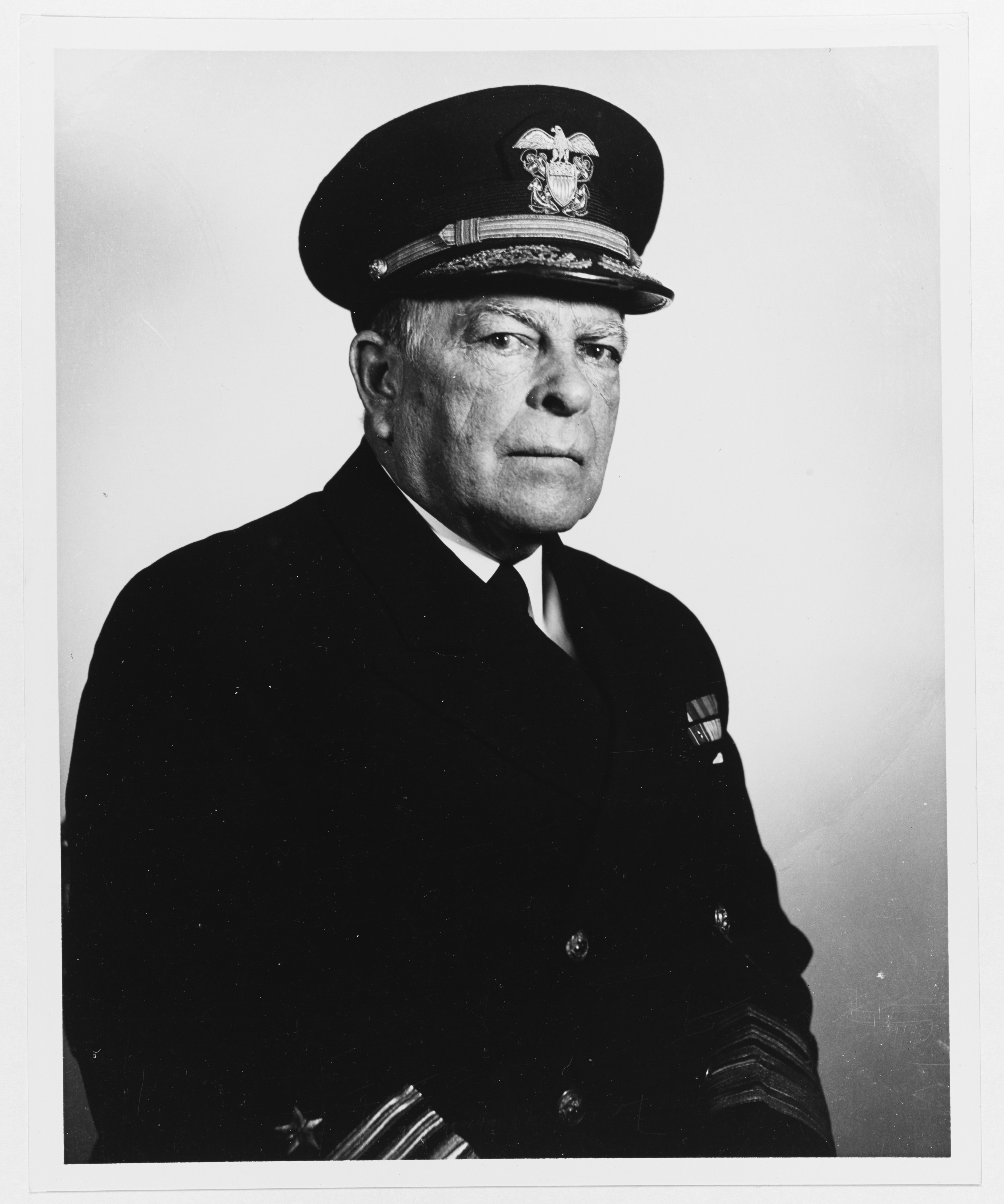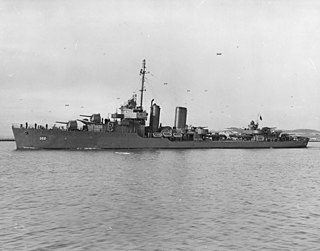
The United States Pacific Fleet (USPACFLT) is a Pacific Ocean theater-level component command of the United States Navy that provides naval forces to the United States Indo-Pacific Command. Fleet headquarters is at Naval Station Pearl Harbor, Hawaii, with large secondary facilities at North Island, San Diego Bay on the Mainland.

The Battle of Leyte Gulf is considered to have been the largest naval battle of World War II and is, by some criteria, a contender for the title "largest naval battle in history", with over 200,000 naval personnel involved. It was fought in waters near the Philippine islands of Leyte, Samar, and Luzon, from 23–26 October 1944, between combined American and Australian forces and the Imperial Japanese Navy (IJN), as part of the invasion of Leyte, which aimed to isolate Japan from the countries it had occupied in Southeast Asia which were a vital source of industrial and oil supplies.

USS Massachusetts (BB-59) is the third of four South Dakota-class fast battleships built for the United States Navy in the 1930s. The first American battleships designed after the Washington treaty system began to break down in the mid-1930s, they took advantage of an escalator clause that allowed increasing the main battery to 16-inch (406 mm) guns, but refusal to authorize larger battleships kept their displacement close to the Washington limit of 35,000 long tons (36,000 t). A requirement to be armored against the same caliber of guns as they carried, combined with the displacement restriction, resulted in cramped ships, a problem that was exacerbated as wartime modifications that considerably strengthened their anti-aircraft batteries and significantly increased their crews.

The United States Fleet Forces Command (USFF) is a service component command of the United States Navy that provides naval forces to a wide variety of U.S. forces. The naval resources may be allocated to Combatant Commanders such as United States Northern Command (USNORTHCOM) under the authority of the Secretary of Defense. Originally formed as United States Atlantic Fleet (USLANTFLT) in 1906, it has been an integral part of the defense of the United States of America since the early 20th century. In 2002, the Fleet comprised over 118,000 Navy and Marine Corps personnel serving on 186 ships and in 1,300 aircraft, with an area of responsibility ranging over most of the Atlantic Ocean from the North Pole to the South Pole, the Caribbean Sea, Gulf of Mexico, and the waters of the Pacific Ocean along the coasts of Central and South America. The command is based at Naval Support Activity Hampton Roads in Norfolk, Virginia and is the navy's service component to U.S. Northern Command and is the Joint Functional Maritime Component Command under the U.S. Strategic Command.

The Sixth Fleet is a numbered fleet of the United States Navy operating as part of United States Naval Forces Europe. The Sixth Fleet is headquartered at Naval Support Activity Naples, Italy. The officially stated mission of the Sixth Fleet in 2011 is that it "conducts the full range of Maritime Operations and Theater Security Cooperation missions, in concert with coalition, joint, interagency, and other parties, in order to advance security and stability in Europe and Africa." The current commander of the Sixth Fleet is Vice Admiral Lisa M. Franchetti.

The Fast Carrier Task Force was the main striking force of the United States Navy in the Pacific War from January 1944 through the end of the war in August 1945. The task force was made up of several separate task groups, each typically built around three to four aircraft carriers and their supporting vessels. The support vessels were screening destroyers, cruisers, and the newly built fast battleships.

The Seventh Fleet is a numbered fleet of the United States Navy. It is headquartered at U.S. Fleet Activities Yokosuka, in Yokosuka, Kanagawa Prefecture, Japan. It is part of the United States Pacific Fleet. At present, it is the largest of the forward-deployed U.S. fleets, with 60 to 70 ships, 300 aircraft and 40,000 Navy, Marine Corps personnel, and Coast Guard support personnel. Its principal responsibilities are to provide joint command in natural disaster or military operations and operational command of all US naval forces in the region.

USS Gambier Bay (CVE-73) was a Casablanca-class escort carrier of the United States Navy. She was sunk in the Battle off Samar during the Battle of Leyte Gulf after helping to turn back a much larger attacking Japanese surface force. She was the only American aircraft carrier sunk by enemy surface gunfire during World War II.

USS Heermann (DD-532) was a World War II-era Fletcher-class destroyer in the service of the United States Navy, named after Fleet Surgeon Lewis Heermann (1779–1833). The ship entered service in 1943 and took part in several battles during World War II in the Pacific theatre of operations, including the Philippines campaign, Battle off Samar and the Battle of Iwo Jima among others. Heermann gained fame during the "last stand of the Tin Can Sailors" in which she and several other destroyers of Task Unit 77.4.3 engaged a far superior Japanese task force during the Battle off Samar in October 1944. Heermann was the only American destroyer of "Taffy 3" to survive the engagement. Following the end of the war in 1945, the ship was placed in reserve from 1946 to 1951, when the destroyer was reactivated. Heermann remained in active service until 1957, when the ship was returned to the reserve. In 1961, Heerman was loaned to Argentina and was renamed ARA Almirante Brown (D-20) while in service with the Argentinian Navy. Almirante Brown remained in Argentinian service until 1982, when the ship was decommissioned.

USS Hoel (DD-533) was a World War II-era Fletcher-class destroyer in the service of the United States Navy, named after Lieutenant Commander William R. Hoel.
A destroyer squadron is a naval squadron or flotilla usually consisting of destroyers rather than other types of vessel. In some navies other vessels, such as frigates, may be included. In English the word "squadron" tends to be used for larger and "flotilla" for smaller vessels; both may be used for destroyer units. Similar formations are used in non-English-speaking countries, e.g., the "escadrille"—which would translate directly as "squadron"—in France.

Vice Admiral William Satterlee Pye, United States Navy, was a U.S. Navy officer who served during World War I and World War II, but never saw combat action. His last active-duty appointment was as President of the Naval War College, in 1942–1946. His awards included the Navy Cross for his distinguished service as a staff officer during World War I.

Thomas Cassin Kinkaid served as an admiral in the United States Navy during World War II. He built a reputation as a "fighting admiral" in the aircraft carrier battles of 1942 and commanded the Allied forces in the Aleutian Islands Campaign. He was Commander Allied Naval Forces and the Seventh Fleet under General of the Army Douglas MacArthur in the Southwest Pacific Area, where he conducted numerous amphibious operations, and commanded an Allied fleet during the Battle of Leyte Gulf, largest naval battle of World War II and the last naval battle between battleships in history.

The third USS Worden (DD-352) was a Farragut-class destroyer in the United States Navy during World War II. She was named for John Lorimer Worden.

USS Haggard (DD-555) was a Fletcher-class destroyer of the United States Navy named for Captain Haggard of the Louisa, who fought in the Quasi-War.

USS Wasatch (AGC-9) was a Mount McKinley-class amphibious force command ship, named after a mountain chain in northern Utah. She was designed as an amphibious force flagship, a floating command post with advanced communications equipment and extensive combat information spaces to be used by the amphibious forces commander and landing force commander during large-scale operations.

United States Naval Forces Central Command (NAVCENT) is the United States Navy element of United States Central Command (USCENTCOM). Its area of responsibility includes the Red Sea, Gulf of Oman, Persian Gulf, and Arabian Sea. It consists of the United States Fifth Fleet and several other subordinate task forces, including Combined Task Force 150, Combined Task Force 158 and others.
Axis & Allies Naval Miniatures: War At Sea is a standalone miniature wargame, produced by Wizards of the Coast. Axis and Allies Naval Miniatures gameplay is similar to that of its sister game, Axis & Allies Miniatures, but the player takes command of Ships, Submarines, and squadrons of Aircraft.
Task Force 61 (CTF-61) is a task force of the United States Navy that today denotes what used to be designated the Mediterranean Amphibious Ready Group (MARG) of the United States Sixth Fleet. It is composed of approximately three Amphibious assault ships, but in 2008 is designated the Expeditionary Strike Group that includes their embarked landing craft. From these ships, United States Marine Corps ground forces can move ashore by sea and air in amphibious assault or emergency evacuation missions. Once ashore, the ships of Task Force 61 are able to logistically support the ground forces, until the objective of the landing has been accomplished.

Carrier Strike Group 15, is a training formation of the United States Navy. It trains and certifies Pacific Fleet Carrier Strike Groups, Amphibious Ready Groups, and independently deploying surface ships. It replaced Commander, Strike Force Training Pacific in a title change.

















